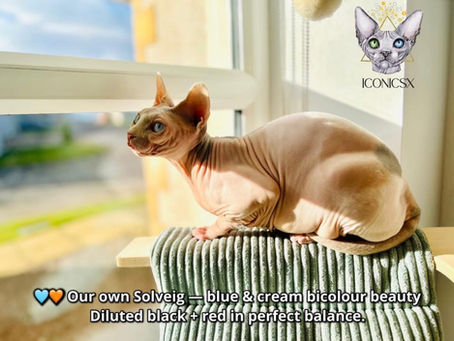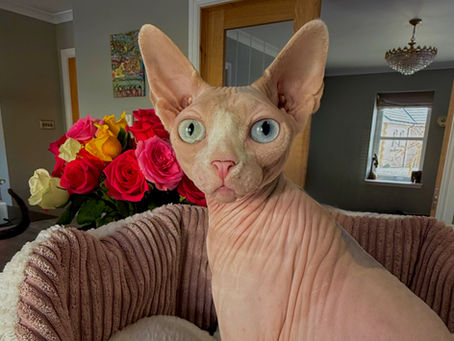top of page


Designer Cats - Have you ever wondered why some cats are labeled as “designer” ?
People love using labels to describe and mark things, events or even each other. It’s easier to stick a tag on something than to understand it. The same thing happens with genes. If a gene creates an unusual look, then it gets labeled as “designer”, which by the way, is still a very elegant way of naming things. This is nothing new in the breeding world, it was always like that. Let's start with a little history lesson and go back to the 1920s. The chocolate and lilac genes.
Iconicsx
Nov 116 min read


GENES DON’T LIE - Dilution Gene — When Colours Go Soft
Not every pastel is what it seems. And not every blue is actually… blue. There’s a little gene (we call it dilution - “d”) that changes the way colour shows up in a cat’s coat — or skin, if you live with a Sphynx. It doesn’t wipe out the pigment; it just spreads it differently. Think of it like mixing paint with water. The colour’s still there, just softer. But here’s the catch: That only happens if the cat gets two copies of the gene (d/d) — one from each parent. Just one?
Iconicsx
Oct 202 min read


GENES DON’T LIE - White Spotted Gene — How Much White Is Too Much White?
You’ve probably seen them — those dreamy white-and-colour cats with just a splash of black on the head, or a tail like it was dipped in paint. They’re called van or harlequin, and their colouring comes from a gene called white spotting — or ws for short. But here’s the twist: Not every cat with this gene looks the same. Some have just cute little socks or a white belly…Others are almost completely white — and yet they don’t carry the gene for dominant white (w) at all. So wha
Iconicsx
Oct 203 min read


GENES DON’T LIE — White Isn’t Just a Colour.
Imagine this: You’ve got a full painting underneath — rich colours, perfect patterns, a story written in genes. Black, blue, tortie…maybe even a classic tabby. But then? Someone pulls a pure white curtain over the whole canvas. And just like that — poof. It’s all gone. That’s what the white gene (symbol: W) does. It’s not really a colour gene in the traditional sense. It’s more like a genetic blackout. Let’s talk about it. What does it do? Just one copy (w/W) is enough to tur
Iconicsx
Oct 202 min read


GENES DON’T LIE : Phenotype vs Genotype - What You See vs What They Really Carry
Every cat has two stories, although most people only notice one of them. The first story is simple because it is written on the surface: the colour of the coat, the shade of the eyes, the length of the body or the shape of the head, the kind of things you notice immediately when you look at a photograph. The second story is harder to read because it is hidden in the genetic code, and even when it does not show on the cat itself it can still be passed on to the kittens, often
Iconicsx
Oct 202 min read


GENES DON’T LIE - Chimera Cat
Chimera cats. People throw that word around too much. Have you seen a cat with a split face and odd eyes advertised as „Chimera”? Most of the time, it’s not. A chimera cat isn’t about looks – it’s about DNA. This phenomenon occurs when, at a very early stage of embryo development, two separate embryos fuse together to become one body. As a result, a cat is made up of two different genetic sets. It depends on what fused: XX/XX – Two female embryos → Female cat, quite often
Iconicsx
Oct 202 min read


When Policy Meets Science: GCCF New Rules for DBE Breeders
How the 2025 Update Impacts DBE Breeders in the UK This week, the GCCF introduced formal registration guidelines for cats carrying Dominant Blue Eye (DBE) variants. There was also a small update — a paragraph in a policy document — but for those of us working transparently with these lines, it meant everything. “The registration policy for the breed does not exclude DBE cats from GCCF registration.” — GCCF Registration Policy, 2025 update For the first time, structure replace
Iconicsx
May 216 min read


HCM in Sphynx Cats : A Closer Look at the Recent ALMS1 and HCM Study: Are We Missing the Full Picture?
There has been growing discussion among breeders about the ALMS1 gene and its connection to hypertrophic cardiomyopathy (HCM) in Sphynx cats. However, some misunderstandings have arisen, particularly in interpreting the clinical data from a recent study. The study focused on a relatively small sample of 55 Sphynx cats. While the data offers valuable insights, it’s important to note that conclusions drawn from such a limited sample should be viewed cautiously. Additionally, si
Iconicsx
Oct 31, 20245 min read
bottom of page


